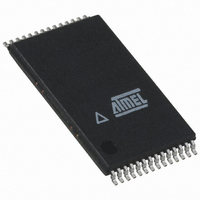AT45DB642D-TU Atmel, AT45DB642D-TU Datasheet - Page 20

AT45DB642D-TU
Manufacturer Part Number
AT45DB642D-TU
Description
IC FLASH 64MBIT 66MHZ 28TSOP
Manufacturer
Atmel
Datasheet
1.AT45DB642D-CU.pdf
(58 pages)
Specifications of AT45DB642D-TU
Format - Memory
FLASH
Memory Type
DataFLASH
Memory Size
64M (8192 pages x 1056 bytes)
Speed
66MHz
Interface
Parallel/Serial
Voltage - Supply
2.7 V ~ 3.6 V
Operating Temperature
-40°C ~ 85°C
Package / Case
28-TSOP
Density
64Mb
Access Time (max)
6ns
Interface Type
Parallel/Serial-SPI
Boot Type
Not Required
Address Bus
1/8Bit
Operating Supply Voltage (typ)
3.3V
Operating Temp Range
-40C to 85C
Package Type
TSOP-I
Program/erase Volt (typ)
2.7 to 3.6V
Sync/async
Synchronous
Operating Temperature Classification
Industrial
Operating Supply Voltage (min)
2.7V
Operating Supply Voltage (max)
3.6V
Word Size
8b
Number Of Words
8M
Supply Current
15mA
Mounting
Surface Mount
Pin Count
28
Data Bus Width
8 bit
Architecture
Sectored
Supply Voltage (max)
3.6 V
Supply Voltage (min)
2.7 V
Maximum Operating Current
15 mA
Mounting Style
SMD/SMT
Organization
256 KB x 32
Memory Configuration
8192 Pages X 1056 Bytes
Clock Frequency
66MHz
Supply Voltage Range
2.7V To 3.6V
Memory Case Style
TSOP
Rohs Compliant
Yes
Lead Free Status / RoHS Status
Lead free / RoHS Compliant
Available stocks
Company
Part Number
Manufacturer
Quantity
Price
Company:
Part Number:
AT45DB642D-TU
Manufacturer:
MICRON
Quantity:
101
Company:
Part Number:
AT45DB642D-TU
Manufacturer:
ATMEL
Quantity:
9 396
Company:
Part Number:
AT45DB642D-TU
Manufacturer:
AT
Quantity:
5
Part Number:
AT45DB642D-TU
Manufacturer:
ATMEL/爱特梅尔
Quantity:
20 000
10.2
10.2.1
20
Security Register
AT45DB642D
Programming the Security Register
The device contains a specialized Security Register that can be used for purposes such as
unique device serialization or locked key storage. The register is comprised of a total of 128
bytes that is divided into two portions. The first 64 bytes (byte locations 0 through 63) of the
Security Register are allocated as a one-time user programmable space. Once these 64 bytes
have been programmed, they cannot be reprogrammed. The remaining 64 bytes of the register
(byte locations 64 through 127) are factory programmed by Atmel and will contain a unique
value for each device. The factory programmed data is fixed and cannot be changed.
Table 10-3.
The user programmable portion of the Security Register does not need to be erased before it is
programmed.
To program the Security Register, the CS pin must first be asserted and the appropriate 4-byte
opcode sequence must be clocked into the device in the correct order. The 4-byte opcode
sequence must start with 9BH and be followed by 00H, 00H, and 00H. After the last bit of the
opcode sequence has been clocked into the device, the data for the contents of the 64-byte user
programmable portion of the Security Register must be clocked in.
After the last data byte has been clocked in, the CS pin must be deasserted to initiate the inter-
nally self-timed program cycle. The programming of the Security Register should take place in a
time of t
is powered-down during the program cycle, then the contents of the 64-byte user programmable
portion of the Security Register cannot be guaranteed.
If the full 64 bytes of data is not clocked in before the CS pin is deasserted, then the values of
the byte locations not clocked in cannot be guaranteed. For example, if only the first two bytes
are clocked in instead of the complete 64 bytes, then the remaining 62 bytes of the user pro-
grammable portion of the Security Register cannot be guaranteed. Furthermore, if more than 64
bytes of data is clocked into the device, then the data will wrap back around to the beginning of
the register. For instance, if 65 bytes of data are clocked in, then the 65th byte will be stored at
byte location 0 of the Security Register.
The user programmable portion of the Security Register can only be programmed one
time. Therefore, it is not possible to only program the first two bytes of the register and then pro-
gram the remaining 62 bytes at a later time.
The Program Security Register command utilizes the internal SRAM buffer for processing.
Therefore, the contents of the buffer will be altered from its previous state when this command is
issued.
Data Type
P
, during which time the Status Register will indicate that the device is busy. If the device
Security Register
0
One-time User Programmable
1
• • •
Security Register Byte Number
62
63
64
Factory Programmed By Atmel
65
• • •
3542K–DFLASH–04/09
126
127













